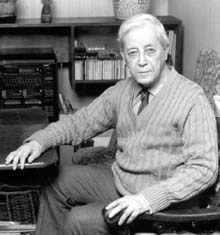Mohammed Dib facts for kids
Quick facts for kids
Mohammed Dib
محمد ديب |
|
|---|---|

Early photo of Dib
|
|
| Born | 21 July 1920 Tlemcen, Algeria |
| Died | 2 May 2003 (aged 82) La Celle-Saint-Cloud, France |
| Occupation | Novelist, poet |
| Language | French |
| Nationality | Algerian |
| Period | 1950s- 2000s |
| Notable works | the Algerian trilogy, an african summer, God in Barbary |
| Notable awards | Fénéon Prize Mallarmé prize |
| Signature | |
Mohammed Dib (Arabic: محمد ديب) was an important writer from Algeria. He was born on July 21, 1920, and passed away on May 2, 2003. He wrote more than 30 novels, plus many short stories, poems, and even books for children. He wrote in French. His books often talked about Algeria's history in the 1900s, especially its struggle to become independent.
Contents
Mohammed Dib's Early Life
Dib was born in Tlemcen, a city in Algeria near the border with Morocco. His family was once middle-class but became poor. After his father died when he was young, Dib started writing poetry at age 15.
When he was 18, he began working as a teacher in Oujda, Morocco. In his twenties and thirties, he had many different jobs. He worked as a weaver, a teacher, an accountant, and an interpreter for the French and British military. He also worked as a journalist for newspapers like Alger Républicain.
How Did Dib Start Writing?
In 1952, just two years before the Algerian War of Independence began, Dib married a French woman. He also joined the Algerian Communist Party and visited France. In the same year, he published his first novel, La Grande Maison (The Great House). Dib was part of a group of Algerian writers from the 1950s. This group included famous authors like Albert Camus.
Life in France
In 1959, the French government made Dib leave Algeria. This was because he supported Algeria's independence. Also, his novels showed the difficult lives of Algerians under French rule, which became very popular.
Instead of moving to Cairo, where many Algerian nationalists went, Dib chose to live in France. He was allowed to stay there because many writers, including Albert Camus, spoke up for him. From 1967, he mostly lived in La Celle-Saint-Cloud, a town near Paris.
Dib's Teaching Career
From 1976 to 1977, Dib taught at the University of California, Los Angeles. He was also a professor at the Sorbonne in Paris. In his later years, he often traveled to Finland. This country became the setting for some of his later novels.
Mohammed Dib passed away in La Celle-Saint-Cloud on May 2, 2003. Jean-Jacques Aillagon, who was the French Culture Minister at the time, said that Dib was like "a spiritual bridge between Algeria and France."
Awards and Recognition
Mohammed Dib received several important awards for his writing:
- 1953 Fénéon Prize
- 1994 The Grand Prix de la Francophonie
- 1998 Mallarmé prize
Mohammed Dib's Books
In his books, Dib wanted to share the real experiences of Algerian life with the world, especially with people who spoke French. The Algerian War of Independence (1954–1962) greatly influenced his ideas. He wanted everyone to know about Algeria's fight for freedom. He believed that "the things that make us different always remain secondary," meaning our similarities are more important. He received many awards from French literary groups.
Famous Novels by Dib
His first novel, La grande maison, was the first part of a series called the Algerian trilogy. This series was about a large Algerian family. The main character, Omar, is a young boy growing up in poverty in Algeria just before World War II. The style of these books is very realistic, similar to the writer Émile Zola.
The second part, L'Incendie, was published in the same year the Algerian revolution started. It was about Omar's life during the Second World War. The last part of the trilogy, Le Métier à tisser, was published in 1957. It tells about Omar's adult life as a working man in Algeria. Parts of this trilogy were based on Dib's own life.
Later Works and Themes
Dib's later books sometimes included surprising or dream-like elements, unlike the realistic style of his early novels. For example, he used science fiction ideas in Qui se souvient de la mer (1962). His last novel, L.A. Trip, was written in verse.
From 1985 to 1994, he wrote four novels that were partly about his own life. These books followed a man from North Africa who visits a Nordic country. He has a relationship and a child with a woman there. The last book in this series is about the child visiting her father's home country. Dib also helped translate several Finnish books into French.
See also
 In Spanish: Mohammed Dib para niños
In Spanish: Mohammed Dib para niños
- List of Algerian writers
- List of African writers

